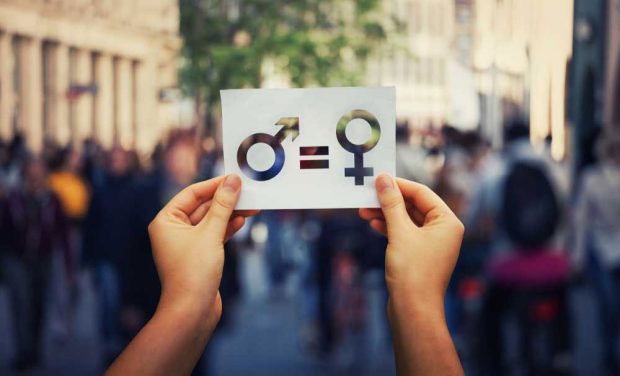
India ranks low at 135th globally for gender parity; worst for health & survival: WEF
PTI, Jul 13, 2022, 3:20 PM IST

Credit: Shutterstock Photo
India was on Wednesday ranked low at 135th place in terms of gender parity, despite an improvement of five places since last year on better performance in areas of economic participation and opportunity.
Iceland retained its place as the world’s most gender-equal country, followed by Finland, Norway, New Zealand and Sweden, as per the annual Gender Gap Report 2022 of the World Economic Forum (WEF) released in Geneva.
Only 11 countries are ranked below India on the index of 146 nations, with Afghanistan, Pakistan, Congo, Iran and Chad being the worst-five.
The WEF warned that the cost of living crisis is expected to hit women hardest globally with a widening gender gap in the labour force and it will take another 132 years (compared to 136 in 2021) to close the gender gap.
The report further said that Covid-19 has set gender parity back by a generation and a weak recovery was making it worse globally.
On India, the WEF said its gender gap score recorded its seventh-highest level in the last 16 years, but it continues to rank among the worst performers on various parameters.
”With a female population of approximately 662 million, India’s level of attainment weighs heavily on regional rankings,” it said.
Recovering ground since 2021, India registered the most significant and positive change to its performance on Economic Participation and Opportunity. But, labour-force participation shrunk for both men and women since 2021.
The share of women legislators, senior officials and managers increased from 14.6 per cent to 17.6 per cent, and the share of women as professional and technical workers grew from 29.2 per cent to 32.9 per cent.
The gender parity score for estimated earned income improved; while values for both men and women diminished, they declined more for men.
However, in the area of political empowerment, the subindex where India ranks relatively higher at 48th place, showed a declining score due to the diminishing share of years women have served as head of state for the past 50 years.
On the health and survival subindex, India ranked the lowest at 146th place and figured among the five countries with gender gaps larger than 5 per cent — the other four being Qatar, Pakistan, Azerbaijan and China.
However, India was ranked the top globally in terms of gender parity for primary education enrolment and tertiary education enrolment and at the eighth place for the position of head of state.
Within South Asia, India was ranked the sixth best on overall score after Bangladesh, Nepal, Sri Lanka, Maldives and Bhutan. Iran, Pakistan and Afghanistan scored worse than India.
South Asia (62.3 per cent) has the largest gender gap of all regions, with low scores across all measured gender gaps and little progress made in most countries since 2021.
At its current pace, it will take 197 years to close the gender gap in the region. The economic gender gap has closed by 1.8 per cent with increases in the share of women in professional and technical roles in countries including Bangladesh and India as well as Nepal.
The WEF said that of the 146 economies surveyed, just one in five has managed to close the gender gap by at least 1 per cent in the past year.
”The cost of living crisis is impacting women disproportionately after the shock of labour market losses during the pandemic and the continued inadequacy of care infrastructure,” WEF Managing Director Saadia Zahidi said.
”In face of a weak recovery, government and business must make two sets of efforts: targeted policies to support women’s return to the workforce and women’s talent development in the industries of the future. Otherwise, we risk eroding the gains of the last decades permanently and losing out on the future economic returns of diversity,” she added.
At the current rates of progress, it will take 155 years to close the political empowerment gender gap — 11 more than predicted in 2021 — and 151 years for the economic participation and opportunity gender gap.
Although 29 countries have reached full parity, it will still take 22 years to close the educational attainment gender gap.
And while more than 140 countries have closed at least 95 per cent of their health gaps, overall backsliding in health and survival means there may be a reversal.
Udayavani is now on Telegram. Click here to join our channel and stay updated with the latest news.
Top News

Related Articles More

Murder accused hurls slipper at judge in Thane court; booked

Record govt jobs provided in one, one and a half years: PM Modi

Kota: Protest at Sasthan Toll opposes charges on local commercial vehicles

Coaching crisis, heartbreaks and Olympic setbacks mark a disastrous year for Indian boxing

Charan Singh dedicated life for welfare of farmers: Adityanath
MUST WATCH
Latest Additions

Murder accused hurls slipper at judge in Thane court; booked

Karnataka: Nine Lord Ayyappa devotees suffer burn injuries in LPG cylinder blast

Record govt jobs provided in one, one and a half years: PM Modi

Man arrested in Kasaragod operated as terror sleeper cell, plotted assassination of Hindu leaders

Enthusiasts express displeasure over omission of Yakshagana at Kannada Sahitya Sammelana in Mandya
Thanks for visiting Udayavani
You seem to have an Ad Blocker on.
To continue reading, please turn it off or whitelist Udayavani.

















